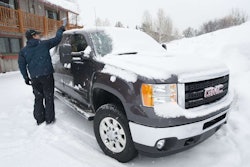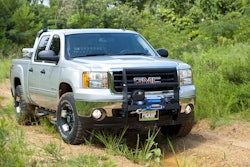COLD SHOTS
by G.R. Whale
Cold-air intakes and intercoolers are a good direction to take if you are serious about gaining an edge in a diesel pickup’s power department

In broad terms, a truck’s internal combustion engine is an air pump.
Air and small quantities of fuel go in, heat converts to mechanical energy and exhaust pumps it out.
Because dense air provides the best bang, bringing cooler air into the engine improves efficiency.
Apart from lower elevation or cooler climates, you may improve intake air by allowing it to flow easier, sourcing it from a cooler location on the truck and, on forced-induction (turbo or supercharger, diesel or gasoline), cooling it further with an aftermarket intercooler.
Intakes and exhausts both have different components that present “corks” on various trucks.
On early Dodge 4WD diesels, the exhaust was crushed around the transfer case, on pre-1999 Power Strokes the down-pipe was semi-flat, on ’98 Ram V8s the passenger’s side exhaust manifold is partially crushed and on other vehicles the muffler or tailpipe is the biggest flow restriction.
Newer vehicles have fewer corks given the data sensed by electronics, but are often limited by cost or assembly/serviceability constraints.
An air intake may add 5 to 10hp on one model and do nothing, or drop power, on another.
A best bet for finding the “cork” on your truck, if one indeed exists, is to check web forums for your specific application.
Its All About Air
Engine parts travel upwards of 875 fpm, thousandths of an inch apart, and a turbo spins to 150,000 rpm. So dirt of any size in the air headed into your engine will cause problems.
That’s why it’s critical to have the best air filter money can buy guarding the intake of your pickup’s engine.
It also has to be kept clean; a clean air filter provides the best air flow, and, in turn, the best power and fuel economy.
 Cold-air intakes like this one from A.E.M. improve air flow and provide more power.
Cold-air intakes like this one from A.E.M. improve air flow and provide more power.
And when it comes to cleaning, sometimes it’s better to ditch the stock air filter for a performance filter or cold-air intake.
Some “performance” filters won’t add any power versus a new stock filter (for example, the stock ’94-‘02 Dodge diesel airbox adequately supplies a 500hp engine).
However, a high-flow performance air filter can handle a lot more dust and dirt before it starts restricting air flow compared to a stock air filter.
Most modern diesels and some gas engines have a restriction gauge (a.k.a. filter minder), and while not the most exact they are a good reminder to check the air filter if you’ve been on a particularly dusty jobsite or had a bird strike on the drive home.
The Power of Cool
ust as a rise in elevation costs power, so does heat: Power drops approximately 1 percent for every 5-6 degrees intake air temperature rises.
It’s not unusual for under-hood temperatures 50 degrees F higher than ambient (hence the insulating layer to keep hood paint from charring), translating to about 10 percent less power.
Some data suggests for every 1 degree drop in intake air temperature, exhaust gas temperature on a turbodiesel drops about 1.5 degrees.
That’s why all turbodiesels have intercoolers. But starting with cooler air helps and one step in that direction is the addition of a cold-air intake system.
A cold-air intake should be exactly that, one that pulls in cool, dry air from outside the engine compartment.
Most late-model pickups have filter enclosures that do this, pulling air from the fender or grille, baffled to keep water out, and foam or rubber seals where ducting enters the compartment.
Virtually all are capable of delivering the engine’s air needs, at 100 degrees, under maximum load. However, if your truck is out of tune, overloaded, or running on poor fuel, an aftermarket cold-air intake may be beneficial.
 High-performance cone filters are usually more efficient than OEM air filters and can often be cleaned and re-used multiple times. (Photo courtesy of aFe.)
High-performance cone filters are usually more efficient than OEM air filters and can often be cleaned and re-used multiple times. (Photo courtesy of aFe.)
Don’t confuse high-performance or low-restriction with cold-air intakes: Bigger tubing with smoother bends promotes airflow. It’s also good to know steel tubes transfer heat faster than plastic ones.
A big cone filter often has more area and less restriction than today’s flat panel filters.
But unless the cone is encased in a box big enough to feed it and pull air from outside the compartment, the power gains may be minimal.
And if you are keen on keeping the noise in your cab to a minimum, keep in mind, a performance intake often adds noise any time the engine is under load because some of the restrictive baffling inside the OEM airbox is there to keep in-cab noise minimized.
Adding an aftermarket cold-air intake, which cost between $250 and $500, typically increases driver awareness of intake and turbo whine.
Intercooling 101-301
Any turbocharger or supercharger compresses air to move more into the cylinders, and compression adds heat.
To counter that increase in heat, all road-going diesels and most factory-supercharged/turbocharged vehicles have a charge air cooler or aftercooler, more commonly known as an intercooler.
On turbodiesels this is an air-to-air or air-to-water radiator that cools the intake air before it enters the engine. At full boost under load, the temperature drop across the intercooler could easily reach 300 degrees.
Like filters and intake systems, a modern turbodiesel’s factory intercooler is adequate for a stock truck driven within design operating standards.
The only service required is keeping the fins clean (as with the radiator, ATF cooler, air conditioner, etc.) and occasionally checking that the hose clamps are tight.
 ATS turbodiesel intercooler is an example of high-performace upgrade beneficial to modified engines.
ATS turbodiesel intercooler is an example of high-performace upgrade beneficial to modified engines.
If you add power, tow overweight or high-drag items, routinely run in desert heat and want air conditioning all the time, upgrading the factory intercooler may be worthwhile.
Intercoolers, which cost between $1,100 and $1,700, have their own language: bar-and-plate; extruded core; tube-and-fin; pressure drop; temperature drop; efficiency and so on.
The intent is to move as much air as possible through the intercooler, decreasing its temperature as much as possible, while maintaining boost pressure.
Cooler air into the cylinders equals lower exhaust gas temperatures (EGT), improving engine longevity.
Each design has advantages and all are a balancing act. The amount of air going through it must be matched by adequate airflow over it to cool said air quantities; too little cooling is as bad as too little airflow through the intercooler.
Making the Best Choice
Most aftermarket intercoolers have a thicker-than-stock core, stronger metal end tanks where some factory parts are plastic, and many have larger ports for use with bigger turbos and intakes.
However, given larger cores, surface area and cooling than stock parts, aftermarket intercoolers have to be balanced with other truck components leading to some questions that need to be addressed:
- Will it drive under-hood temperatures higher, leading to faster wear of rubber and plastic parts?
- Will it clear any PTO, plow, hydraulic or lighting upgrades?
- More important, if you stuff a huge intercooler in the truck, EGT will go down, but will there be enough air passing the intercooler to handle heat from the engine coolant or ATF cooler?
 Banks Engineering offers a complete intercooler and intake kit for today's diesels.
Banks Engineering offers a complete intercooler and intake kit for today's diesels.
Consider my antique turbodiesel with aftermarket turbo and intercooler. With maximum boost set at 20 psi, EGT rises faster on long pulls than coolant temperature (and oil cooled on the same circuit).
If max boost is set at 25 psi, EGT is lower but the warmer air coming off it makes coolant temp rise much faster and take longer to come down.
The happy medium on this example is 22 psi where EGT, coolant and oil all rise in sync.
The Bottom Line
The factory air cooling systems on late-model pickups are hard, but not impossible to beat. A good cold-air intake might add 10hp or 0.1 mpg to your 300hp truck, but ROI can stretch to a million miles.
Bigger gains from the installation of an intercooler or cold-air-intake upgrade will show on a tweaked diesel, and certain aftermarket programmer’s power levels mandate such upgrades.
An intercooler will help on overloaded trucks or those working hard in high heat, too.
But any intercooler change should include the addition of an EGT gauge and careful monitoring of all coolant temperatures.
The Dyno Debate
Parts manufacturers like to quote performance gains measured on a dyno. Just keep in mind such numbers are not always real-world and should be backed up with over-the-road data.
Most dynos can provide near-ideal repeatability and correct for temperature and atmospheric pressure while huge fans provide cooling air, which may or may not equal truck speed at that engine output.
 Hypertech spends an enormous amount of time and a very finely-tuned methodology running pickups on their dynos studying and fine-tuning their programmers -- and other manufacturer's aftermarket engine upgrades.
Hypertech spends an enormous amount of time and a very finely-tuned methodology running pickups on their dynos studying and fine-tuning their programmers -- and other manufacturer's aftermarket engine upgrades.
And an open hood during the dyno runs allows heat out and cooler air in, and the brevity of a dyno pull means the under-hood temperature never reaches where it runs on the road, towing a grade or slogging through traffic and the transmission stays cool, never adding heat to the cooling stack.
I spent an entire day watching a skilled dyno operator and the truck-maker’s engineer get rated horsepower and torque out of a stock truck, and they eventually did, but never coincidentally.
Without changing any component on the truck, power and torque varied by more than 45 percent, merely by dyno manipulation and correction factors.
Dyno results can be useful as long as the methodology is clear, and is best backed up by acceleration and grade-climb times. – GRW







